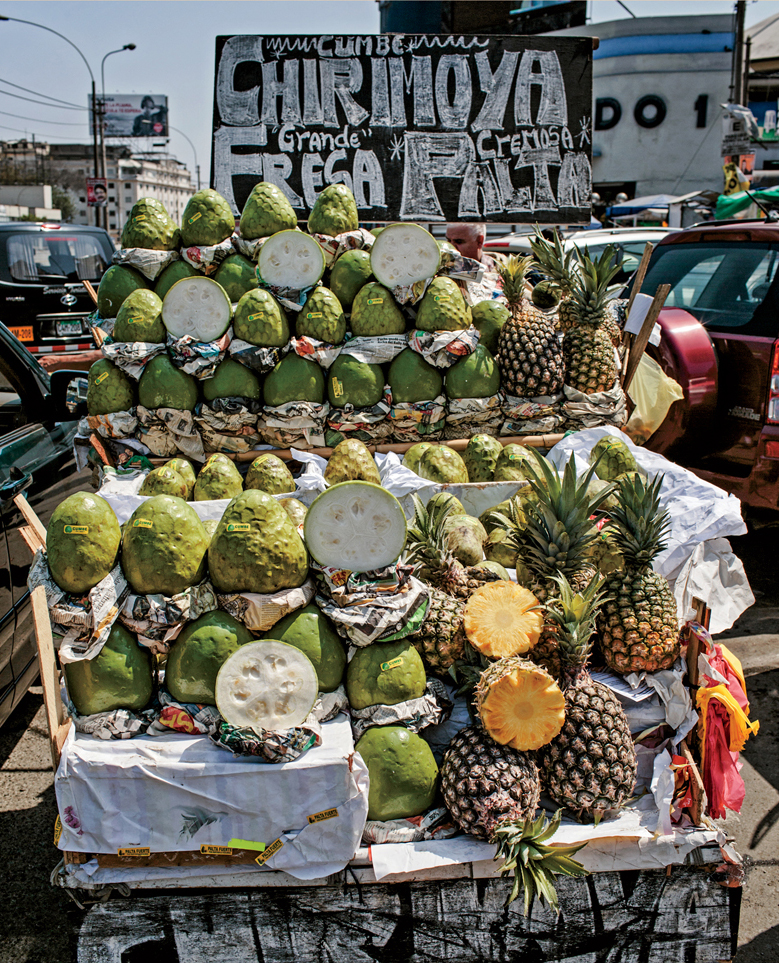Frutas (Fruits)
When you live in a country with a true jungle like the Amazon, it seems like there are always new fruits to taste. Some, like tumbo, a tangier variety of passion fruit, and camu camu, another acidic native fruit that is cooked down in sauces or used in baked desserts, should be added to your list to try in Peru. These are a few of my favorites that are usually easier to find in the United States.
Caigua
Technically a fruit, caigua has been eaten more like a vegetable at least since the Moche era. Look closely, and you will see the fruit depicted in their artworks and ceramics alongside corn and other produce. It resembles a long green chile pepper and tastes somewhat like a mix between a cucumber and a bell pepper. Caigua are usually pickled and used in salads, sautéed, or stuffed (the fruit conveniently has a generous cavity in the center, which is why it is sometimes referred to as pepino de rellenar, or “stuffing cucumber”). Your best bet for finding caigua in the United States is usually Latin markets, but I’ve also seen them at my local farmers’ markets. I really love them stuffed and baked or steamed. Cut a few inches off the tip and scrape out the seeds and veins so you can stuff the whole caigua with whatever you like (papas rellenas filling, page 179, is very good), then bake the caiguas rellenas in homemade tomato sauce until tender, or steam them and serve them with the sauce on the side.
Chirimoya (Cherimoya)
The fruit may not look so pretty on the outside, with light green, scaly skin, but when mature, the soft, cream-colored flesh of cherimoya is beautiful—and so good. It tastes like a mix of strawberry, banana, and tropical flavors that are difficult to describe. (Guanábana, soursop, another jungle fruit that has become popular outside of Peru recently, is in the same family.) The Incas considered the fruit, which they called chirimuya, an aphrodisiac, and some of the first Europeans to taste it called cherimoya the “pearl of the Andes.” For a long time, you couldn’t find the the fruit very far from where it was grown because it bruises very easily, but today, you can find cherimoya individually wrapped in a protective Styrofoam “cages” at good grocery stores and some farmers’ markets in winter through early spring. Let the fruit ripen at room temperature until almost as soft as an avocado, then refrigerate the cherimoya (unpeeled) for a few days before peeling.
Lúcuma (Lucuma)
The sweet and slightly starchy fruit known as “the lost gold of the Incas” looks like a large avocado, complete with a pit. Beneath the green skin is bright orange flesh that, when ripe and pureed into ice cream, tastes almost like a tropical version of maple syrup, only not so creamy and perfect. Pureed into a pulp for puddings or ice cream, the gold reference is claro, clear. It’s not always easy to find fresh; if you find the frozen pulp, check the ingredients to make sure it’s just the pureed fruit. The fruit is grown all over northern South America and Central America, with many of the exports simply labeled “lucuma,” which could refer to the pureed fruit or to derivatives like sorbets with sugar.
Maracuyá (Passion Fruit)
Native to the Brazilian Amazon, the fruit of the “climbing plant” has a unique, tart-yet-sweet pulp. It tastes like a tropical mash-up of guava, pineapple, and lime juice. You don’t usually need much, a good thing, as the fruits only have a good spoonful or so of pulp in the center. Most passion fruits that you find in the States are the purple variety, and should be good and wrinkly on the outside. The wrinkles are a sign that the fruit pulp is at its peak. Other, larger varieties are usually processed for pulp. Slice open the fruit over a bowl to catch all of the juices, and save the crunchy, greenish-black seeds with any of the remaining tangy pulp clinging to them to sprinkle on yogurt or ice cream. If you can’t find the fresh fruit at your local supermarket or specialty grocer, look for the pure, frozen pulp without added sugar. One tablespoon of the frozen pulp is about the equivalent of the strained pulp of one passion fruit.
Platanos (Plantains)
Native to Africa, plantains spread all over Latin America after arriving with slaves brought by explorers and European settlers. The fruit adapted well to its new home both agriculturally and within the country’s various cooking styles. Plantains are used at various stages of ripeness. When the skin is still green and the flesh very firm, they are usually fried, as in plantain chips. When the skin turns black, the soft, creamy flesh is very tender and sweet. In Peru, we usually mash it up to make dishes like Tacacho (page 207), fried plantain cakes that are sold by street vendors.
